The NVIDIA GeForce GTX 980 Review: Maxwell Mark 2
by Ryan Smith on September 18, 2014 10:30 PM ESTThief
Our latest addition to our benchmark suite is Eidos Monreal’s stealth action game, Thief. Set amidst a Victorian-era fantasy environment, Thief is an Unreal Engine 3 based title which makes use of a number of supplementary Direct3D 11 effects, including tessellation and advanced lighting. Adding further quality to the game on its highest settings is support for SSAA, which can eliminate most forms of aliasing while bringing even the most powerful video cards to their knees.
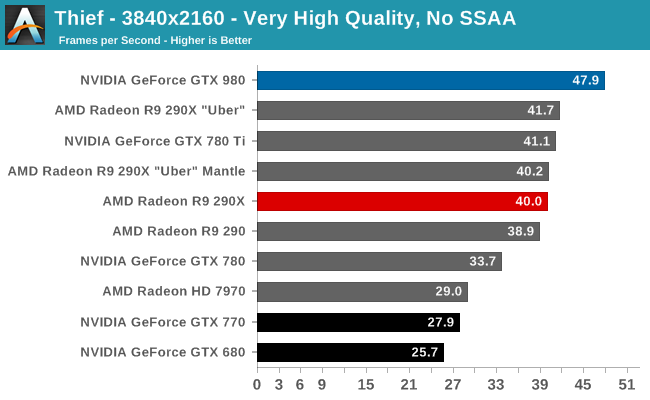

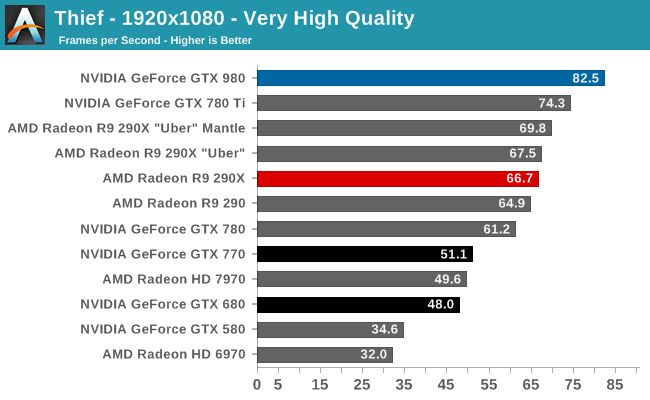
Thief is another solid win for the GTX 980. The closest anyone gets to it is within 10%, and the lead only widens from there. Against the GTX 780 Ti, this is a lead of anywhere between 10% and 16%, and against the R9 290 XU it’s 15-22%; Mantle doing the card no favors for average framerates above 1080p.
The performance advantage over the GTX 780 and GTX 680 is also above average. GTX 980 can outrun the previous x80 card by 33% or more, and the GTX 680 by at least 80%.
On an absolute basis the GTX 980 won’t quite crack 60fps at 1440p, but it does come very close at 56fps. And since thief is running an internal form of SSAA, turning up the resolution to 4K and dropping the SSAA still yields playable framerates, though at 48fps it’s closer to 45 than 60. 60fps is going to require a bit more horsepower than what a single GTX 980 can deliver today.
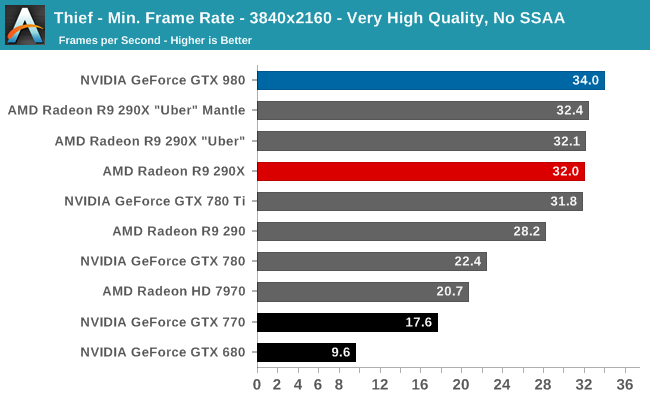
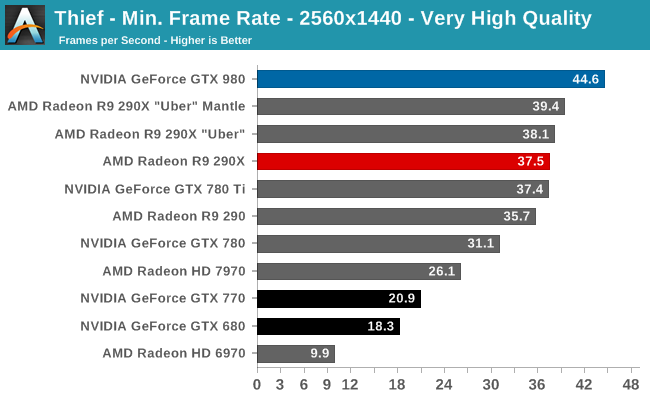
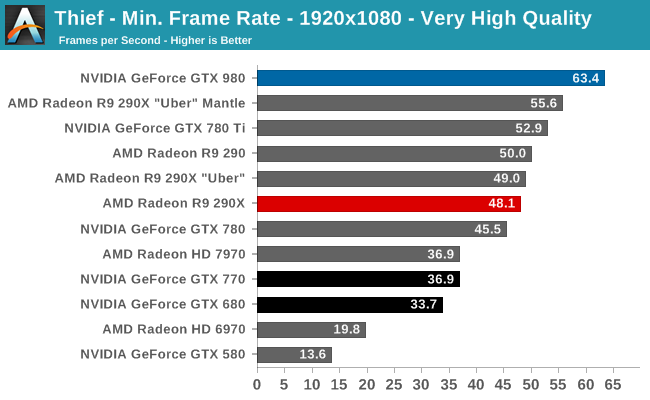
The GTX 980’s performance advantage generally holds up when it comes to minimum framerates as well. Though it is interesting to note that until we get to 4K, the GTX 980 holds a larger minimum framerate advantage over the GTX 780 Ti than it does an average framerate advantage – 20% verus about 10%. On the other hand the use of Mantle begins to close the gap for the R9 290XU a bit, but it’s still not enough to make up for the GTX 980’s strong overall performance advantage, especially at 1080p.


Our delta percentages are once more unremarkable. All cards are consistently below 3% here.


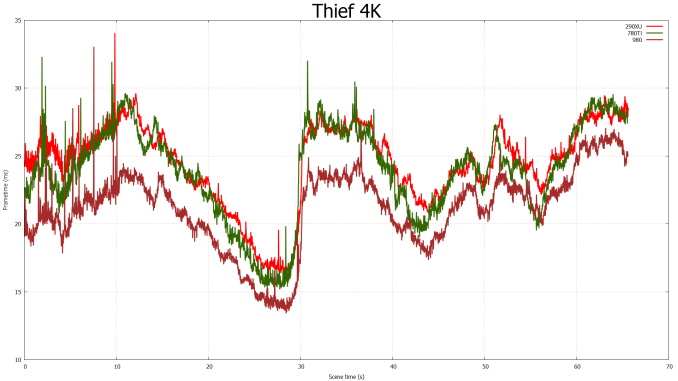








274 Comments
View All Comments
garadante - Thursday, September 25, 2014 - link
Yeah. To be honest nobody except ardent Nvidia fanboys would've believed Nvidia would release cards as performance and price competitive as they did, especially the 970. The 980 is honestly a little overpriced compared to a few generations ago as they'll slap a $200 premium on it for Big Maxwell but $330 MSRP for the 970 (if I remember correctly) wasn't bad at all, for generally what, 290/780/290X performance?tuxRoller - Friday, September 26, 2014 - link
It's not too surprising as we saw what the 750ti was like.What is disappointing, though, is that I thought nvidia had made some fundamental breakthrough in their designs where, instead, it looks as though they "simply" enabled a better governor.
garadante - Friday, September 26, 2014 - link
It'll be interesting to see how the efficiency suffers once nvidia releases a proper compute die with area dedicated to double precision FP. I have to keep in mind that when factoring in the stripped down die compared to AMD's 290/290X cards, the results aren't as competition. Lowing as they first seem. But if AMD can't counter these cards with their own stripped down gaming only cards then nvidia took the win this generation.tuxRoller - Friday, September 26, 2014 - link
That's an excellent point. I take it you already read the tomshardware review? They're compute performance/W is still good, but not so unbelievable as their gaming performance, but I'm not sure it's b/c this is a gaming only card. Regardless, though, amd needs to offer something better than what's currently available. Unfortunately, I don't think they will be able to do it. There was a lot of driver work than went into making these maxwell cards humgaradante - Friday, September 26, 2014 - link
One thing that really bothers me though is how Anandtech keeps testing the 290/290X with reference cards. Those cards run at 95 C due to the fan control profile in the BIOS and I remember seeing that when people ran those cards with decent nonreference cooling in the 70 C range that power consumption was 15-20+ watts lower. So an AMD die that sacrifices FP64 performance to focus on FP32(gaming, some compute) performance as well as decreasing die size due to the lack of FP64 resources seems like it could be a lot more competitive with Maxwell than people are making it out to be. I have this feeling that the people saying how badly Maxwell trounces AMD's efficiency and that AMD can't possibly hope to catch up are too biased in their thinking.tuxRoller - Saturday, September 27, 2014 - link
Do you have a link to those reviews that show non-reference fans make gpus more efficient? I don't know how that could be possible. Given the temps we're looking at the effects on the conductors should be very, very small.Regarding the reduction in fp performance and gaming efficiency, that's a good point. That may indeed be part of the reason why nvidia has the gaming/compute split (aside from the prices they can charge).
garadante - Sunday, September 28, 2014 - link
Here's an example of a card with liquid cooling. Factor in the overclock that the nonreference card has and that it draws something like 20 watts less in Furmark and the same in 3Dmark. I could be mistaken on the improved power usage but I do recall seeing shortly after the 290X launch that nonreference coolers helped immensely, and power usage dropped as well. Sadly I don't believe Anandtech ever reviewed a nonreference 290X... which is mind boggling to consider, considering how much nonreference cooling helped that card, even outside of any potential power usage decreases.garadante - Sunday, September 28, 2014 - link
http://www.tomshardware.com/reviews/lcs-axr9-290x-... Whoops, forgot the link.jman9295 - Friday, September 26, 2014 - link
I wonder why they still give these cards these boring numbered names like GTX 980. Except for the Titan, these names kinda suck. Why not at least name it the Maxwell 980 or for AMD's R( 290 series the Hawaii 290. That sounds a lot cooler than GTX or R9. Also, for the last several generations, AMD and Nvidia's numbering system seems to be similar up until AMD ended that with the R9/R7 200 series. Before that, they had the GTX 700 and HD 7000 series, the GTX 600 and HD 6000 series and so on. Then, as soon as AMD changed it up, Nvidia decides to skip the GTX 800's for retail desktop GPUs and jump right up to the 900 series. Maybe they will come up with a fancier name for their next gen cards besides the GTX 1000's.AnnonymousCoward - Saturday, September 27, 2014 - link
Naw, names are much harder to keep track of than numbers that inherently describe relative performance.